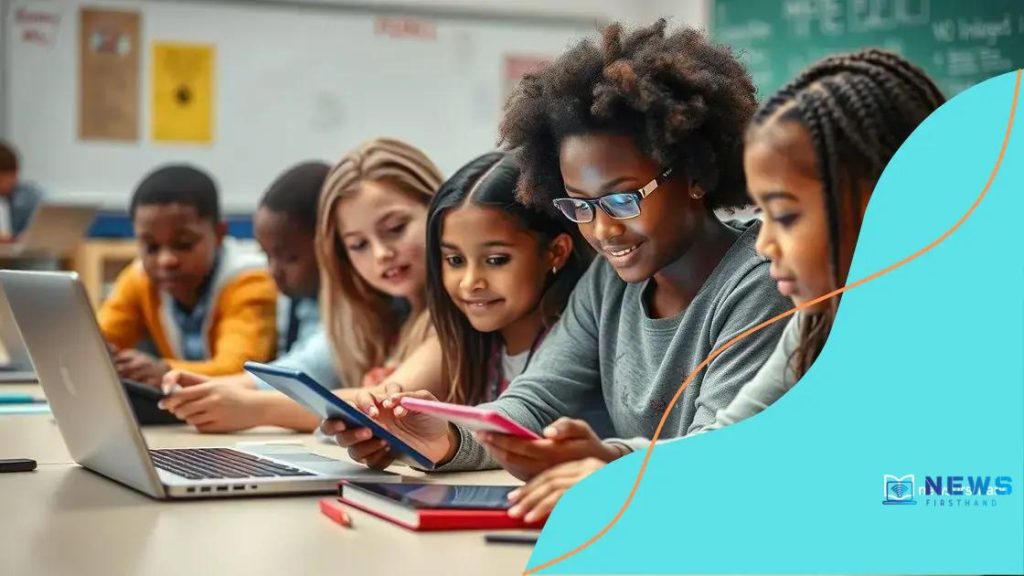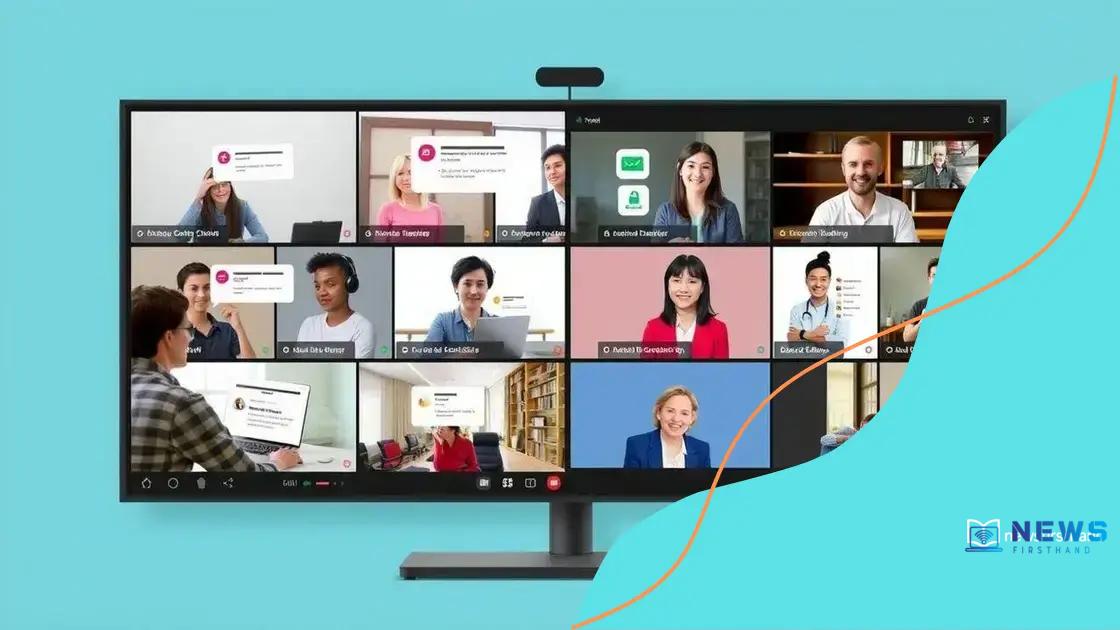Bridging the gap in digital learning opportunities

Measuring the impact of digital learning initiatives is crucial for identifying their effectiveness, involving key metrics such as student engagement, academic performance, and user satisfaction to enhance educational practices.
Bridging the gap in digital learning opportunities is more crucial than ever. With the rise of online education, ensuring equitable access to resources and technology fosters better learning outcomes. Have you thought about how these shifts impact your own learning journey?
Understanding digital learning opportunities
Understanding digital learning opportunities is crucial in today’s educational landscape. With technology advancing rapidly, students and educators alike must adapt to these changes. By leveraging various digital tools, learning can become more engaging and accessible.
What Are Digital Learning Opportunities?
Digital learning opportunities refer to educational experiences facilitated through technology. This includes online courses, interactive webinars, and virtual classrooms. These methods provide flexible options for learners of all backgrounds.
Benefits of Digital Learning
- Increased accessibility for students in remote locations.
- Customization of learning experiences to fit individual needs.
- Access to a wealth of online resources and materials.
- Enhanced collaboration through digital platforms.
As we explore the landscape of digital learning, it’s essential to recognize the role of accessibility. When opportunities are available to everyone, the potential for improved educational outcomes increases. Moreover, technology can bridge gaps in understanding by providing instant feedback and resources tailored to each learner’s pace.
Another aspect of digital learning is the ability to engage with diverse multimedia content. Students can interact with videos, podcasts, and interactive quizzes, making lessons more dynamic. This varied approach caters to different learning styles and encourages active participation.
In addition, digital learning environments often foster a sense of community. Students can participate in discussion forums and collaborate on projects, creating a support system that encourages learning beyond traditional barriers.
The importance of accessibility in education
The importance of accessibility in education cannot be overstated. Every learner deserves equal access to educational resources, regardless of their background or abilities. Ensuring that students can engage with materials effectively creates a more inclusive environment.
Defining Accessibility in Education
Accessibility means designing learning experiences that cater to all students, including those with disabilities. This includes providing materials in different formats, such as text, audio, or video, so everyone can participate fully.
Benefits of Accessible Education
- Promotes equity among learners.
- Encourages diverse perspectives and ideas.
- Enhances overall learning outcomes.
- Fosters a sense of belonging within the classroom.
A focus on accessibility allows educators to remove barriers that can hinder learning. For instance, using captions on videos or screen readers can greatly benefit students with hearing or visual impairments. These adjustments not only help individuals but also enrich the learning experience for everyone.
Furthermore, incorporating accessible practices encourages innovation. Educators can utilize a variety of teaching tools, enhancing engagement and interaction in the classroom. With the right resources, all students can thrive and develop their potential—a crucial goal in today’s educational framework.
By prioritizing accessibility in education, we create a future where learning opportunities are equitable. Every student should be able to succeed without facing unnecessary obstacles. This commitment to accessibility will undoubtedly lead to a more informed and inclusive society.
Strategies for effective online engagement

Strategies for effective online engagement are essential for maximizing learning in digital environments. When students are actively involved, their understanding deepens. This engagement is crucial as it enhances motivation and helps retain information.
Creating Interactive Content
To foster engagement, educators should focus on creating interactive content. This includes quizzes, polls, and discussion forums. Interactive elements encourage students to actively participate instead of passively consuming information.
Utilizing Multimedia Resources
Incorporating multimedia—such as videos, podcasts, and animations—can make lessons more compelling. Students often respond better to varied formats because they cater to different learning styles. This diversity keeps content fresh and exciting.
- Videos can illustrate complex concepts visually.
- Podcasts allow for deep dives into specific topics.
- Animations simplify difficult ideas with engaging visuals.
Another effective approach is to establish a sense of community. Encouraging students to collaborate on group projects can strengthen relationships. When students feel connected, they are more likely to engage actively with the content and each other.
Additionally, timely feedback is critical for online engagement. Providing feedback on assignments not only helps students improve but also shows them that their efforts are valued. Regular check-ins and personalized comments can encourage continued participation.
Lastly, setting clear expectations is vital. When students know what is required of them, they are more likely to stay motivated and engaged. Clear guidelines about participation, assignments, and deadlines help eliminate confusion and promote a productive learning environment.
Technology’s role in enhancing digital learning
Technology’s role in enhancing digital learning is vital in today’s educational landscape. Educational tools are evolving, making learning more interactive and accessible. With the right technology, students can explore concepts in ways that were not possible before.
Innovative Learning Tools
Various innovative tools contribute to digital learning. Learning management systems (LMS) offer platforms where students can access resources, submit assignments, and communicate with peers and instructors. These systems streamline the educational process and reduce the barriers to learning.
Personalized Learning Experiences
Technology allows for personalized learning experiences. Adaptive learning software can adjust the difficulty of tasks based on student performance. This ensures that each learner can progress at their own pace, making education more effective and engaging.
- Online quizzes provide instant feedback.
- Interactive simulations enable hands-on practice.
- Video tutorials offer flexible learning options.
Furthermore, technology can foster collaboration among students. Tools like video conferencing and group work applications enable students to work together from anywhere. This connection is especially important in online learning environments, where building relationships can be challenging.
In addition to facilitating collaboration, technology enhances engagement through multimedia resources. Videos, podcasts, and infographics can make complex material easier to understand and remember. When students engage with content through various media, they are more likely to retain information.
Ultimately, the integration of technology in education transforms traditional teaching methods. As schools adapt to these changes, they will continue to discover new ways to enhance digital learning and support students in their educational journeys.
Measuring the impact of digital learning initiatives
Measuring the impact of digital learning initiatives is essential for understanding their effectiveness. As more schools and organizations adopt digital learning, it is crucial to evaluate how well these programs benefit students. Gathering data helps identify strengths and weaknesses, improving future strategies.
Key Metrics for Evaluation
There are several key metrics to consider when evaluating digital learning initiatives. These metrics include student engagement, academic performance, and user satisfaction. Tracking these aspects gives a comprehensive view of how well programs are working.
Student Engagement
Measuring student engagement can involve looking at participation rates in online activities. High engagement often correlates with better learning outcomes. Tools like surveys and analytics from learning management systems (LMS) can provide valuable insights.
- Attendance in virtual classes or sessions.
- Frequency of participation in discussions or forums.
- Interaction with available resources and materials.
Further analysis of academic performance must also consider grades, completion rates, and mastery of skills. Comparing these results against traditional learning methods can reveal the effectiveness of digital approaches. For instance, using assessments to gauge understanding and retention will show whether digital methods are improving knowledge acquisition.
Another important aspect is user satisfaction. Collecting feedback from students, parents, and educators helps identify what works well and what needs improvement. Surveys and focus groups can highlight areas like content quality, platform usability, and support services.
Finally, it is essential to include long-term outcomes in the evaluation. Tracking students over time can reveal how digital learning impacts their academic and professional paths. By compiling this data, educators can better understand the lasting effects of digital learning initiatives on student success.
In conclusion, measuring the impact of digital learning initiatives is crucial for enhancing educational practices. By tracking engagement, performance, and satisfaction, educators can identify areas for improvement. This process ensures that online learning environments are effective and accessible for all students. Continuous evaluation helps foster an enriching educational experience, guiding future implementations of digital learning strategies.
FAQ – Questions about Measuring the Impact of Digital Learning Initiatives
Why is measuring the impact of digital learning initiatives important?
It’s essential to evaluate their effectiveness, ensuring that they provide real benefits to students and help refine educational practices.
What metrics should be used to assess digital learning?
Key metrics include student engagement, academic performance, and user satisfaction, which provide a comprehensive view of the program’s success.
How can student engagement be measured?
Student engagement can be measured by tracking participation rates, interactions in online discussions, and the frequency of resource utilization.
What role does feedback play in digital learning evaluation?
Collecting feedback from students and educators helps identify strengths and areas for improvement, guiding future implementations of digital learning strategies.





